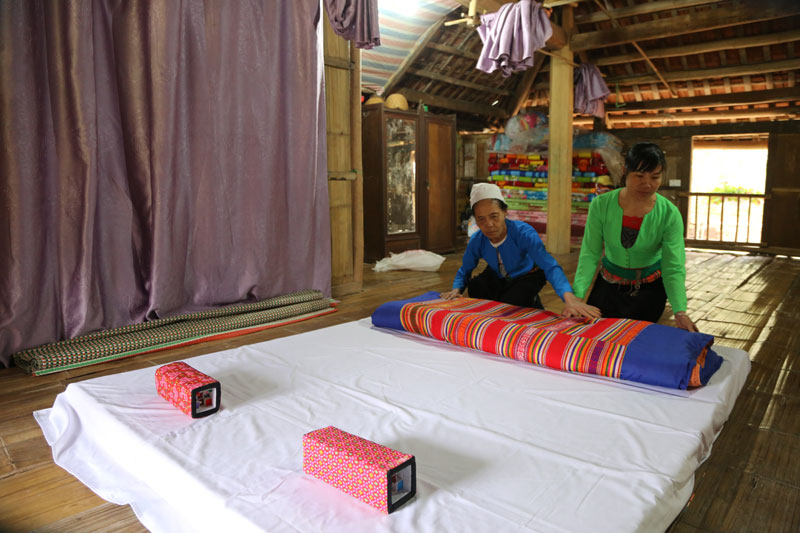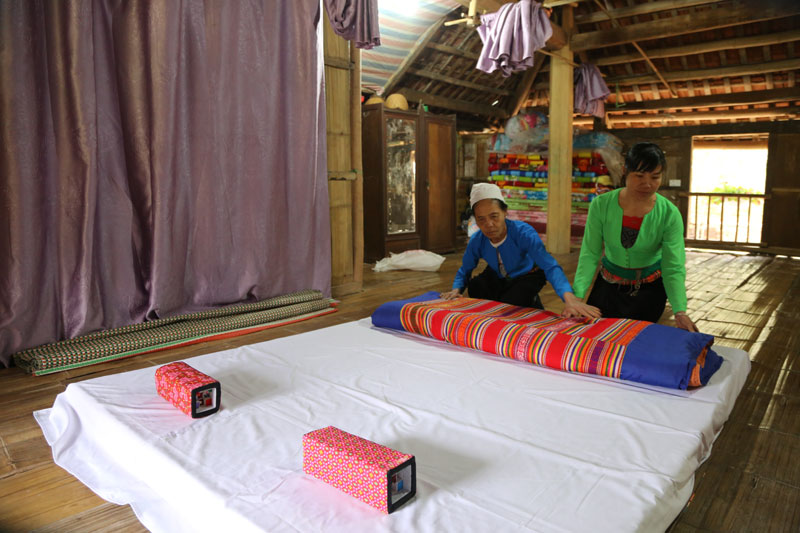



Villagers Ai Village, Phong Phu Commune (Tan Lac) have been trained about community tourism skills. Photo: Bui Thi Quynh's family preparing a getaway for tourists.
The center of the village has 34 Muong ethnic households. All the households have still kept the traditional stilt houses with turtle-shaped architectures noted in the famous epic "Land Laying, Water Laying".
Visitors can take a walk on the winding road to enjoy the wild beauty and stop at any stilt houses to learn more about Muong ethnic culture. Muong ethnic people here are friendly and hospitable. They still keep the traditional way of cooking with fireplace, ethnic clothing and many ancient tools used in production such as weaving loom, rice mill, rice mortar, bow, crossbows, farming hoes, etc.
Muong ethnic people live mainly on cultivation and livestock breeding. Coming to Ai village, visitors can experience the daily activities of the villagers such as farming, vegetables, fishing, caring for cattle, poultry, bamboo shoot picking, dying cloth, etc. With the owner of the house, travelers can cook the special dishes such as steamed fish, sticky steam rice, chicken cooked with sour bamboo shoot, etc., and learning to make traditional crafts, souvenirs from bamboo, or participating folk games with the local people: plate hitting, stick pushing, crossbow shooting, etc. Especially, the people of Ai village still preserve many intangible cultural values such as the songs of Thuong Rang, Bo Meng, Mo rhymes, gong echo, etc. Each family still holds 1 to 3 gongs. The gong set of the village has 21 gongs. The village has a Mo person who is recognized as an artist, and there is also a musical team for the funeral and festival service.
With unique cultural values, in 2008, Ai village was recognized by the Ministry of Culture, Sports and Tourism as a typical traditional village of ethnic minorities and representative village of Muong ethnic minority building 20 traditional villages of the country. By 2014, the provincial People's Committee already recognized the community tourism of Ai village. In recent years, Ai village is in good condition, clean and beautiful; people are planting flowers along the aisles, in front of the house. The situation of keeping buffaloes under the floor, pig cages and chicken cages right next to the house has been changed. Villagers participate in homestay courses.
Ms. Bui Thi Quy, owner of Muong Bi homestay, said: "My family's stilt house is over 60 years old, I keep the ancient house space. Preserving the traditional culture identity also means developing community tourism. Since then, we have introduced and advertised Muong ethnic culture to visitors, and increased income. We welcome guests with sincere, rustic heart to give visitors a good impression. From the year of 2015 until now, my family has received many delegations from various provinces and cities in the country to foreigners such as France and the US ... and they show their interest."